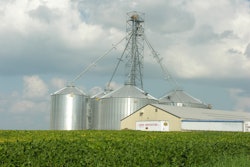As summer nears its end, elevators are preparing for an influx of grain: cleaning bins, inspecting machinery and investing in new equipment to handle what will no doubt be another record harvest. During this time new employees will be brought on board, and seasoned veterans will be bracing themselves, knowing what to expect from peak time. In the midst of making these necessary preparations, management also be reviewing its safety and training policies.
Ask yourself: When was the last time our facility had grain engulfment training? For new employees and old, annual grain entrapment education and training is essential in preventing the unthinkable.
According to Purdue University’s Agricultural Safety & Health Program’s National Grain Entrapment Database, a log tracking entrapment cases since 1964, 38 grain entrapments occurred in 2009. This is up roughly 10% from 2007 and 2008; and the highest recorded number since 1993.
Entrapment incidents have been trending upward, but what’s driving this upswing?
Many point to the sheer volume of grain — corn in particular — being produced and handled in the United States. While other commodities can also pose a threat to careless individuals, most entrapment incidents occur in corn bins.
“Aside from the amount of corn being handled, the condition of the last harvest has contributed to the recent spike in the number of fatalities,” he says. Facilities are also storing grain for longer than they were 20 years ago – in part because of the year-round demand for ethanol — adding to the quality issue.
In fact, the common thread linking most engulfment incidents can be traced back to poor grain quality. Bridging and other problematic formations create situations where employees see the need to enter the bin to dislodge grain. Perhaps one of the solutions in combating engulfment incidents is simply keeping grain in condition.
“If we’ve done our job putting grain into storage and maintaining it once it’s in there — there’d be no reason to enter a bin,” Jones says. “The best way to combat engulfment is by avoiding a situation where people feel compelled to enter the bin.”
She notes that frequent monitoring allows the elevators to detect quality issues before it reaches a point when it is necessary to enter a bin to remediate the problem
除了粮食质量,安装和更安全more efficient systems will deter bin entrance. As new equipment is installed or existing structures are retrofitted with new equipment, Bauer suggests, for example, elevators add larger discharge sump holes (24’ X 24’) and decent service tunnels under the floor of the bin (7-ft. high with good lighting and drainage) so employees can work safely and comfortably.
Bauer suggests the general state of the economy has also added to this trend line. As businesses run leaner than ever, the lack of excess labor may put employees in a position to attempt to clean a bin alone rather than with proper oversight.
Another, more fundamental factor: The refusal to acknowledge that grain can be dangerous, and treat it accordingly.
“It’s a human instinct to believe they are initially safe and hate to admit there is a hazard in what we’re doing,” Baker says. “No one wants to admit it could happen to them.”
While the factors contributing to these increased incidents are out of commercial facilities, preventing incidents through proper safety training and by providing equipment is not.
PREVENTION TIPS
Despite the level of experience an employee might have, new and seasoned employees alike are at risk for getting themselves into trouble – a combination of arrogance fueled by perceived experience (“I’ve done this a million times and nothing happened”) and naivety due to lack of proper training.
“You can’t assume every new employee comes to us with any training – there’s just too much at stake – so every employee needs to have some sort of training with in the first few days of their employment that covers conditioning and safety,” Jones explains.
Accidents do happen, and it is the responsibility of the elevator to provide every opportunity to prevent it from happening. As elevators seek out training programs for their employees, there are five fundamental principals of engulfment prevention that can be stressed immediately:
1)Keep people out of the bins
Don’t enter the bin unless absolutely necessary. “People get pretty cavalier about getting in and out of bins —especially if they’ve been doing it their entire career,” Bauer says.
Bauer and Jones suggest elevators take a serious look at its grain conditioning and reclaim systems to combat this necessity.
“Grain quality preservation and better equipment are the answer, the answer is not to climb into the bottom of the bin and poking around — which unfortunately seems to be the standard method right now,” Jones says.
2)Never enter a bin alone
Should you need to enter a bin, never under any circumstance should you work alone.
“Whether it’s a commercial operation or a farm, it is imperative for an individual to work with an observer or an attendant,” Baker says.
3)Adequate hands-on training
The best way to become familiar with safety and rescue equipment is by working with the equipment first hand.
“大多数设施需要take training more seriously,” Bauer says. “Most do not provide appropriate hands-on training to the entrants and observers. You can’t teach some of the skills we’re concerned about people knowing in a classroom or a lecture in a break room.” He suggests training sessions consist of both classroom and in-the-field instruction.
To ensure an understanding of the safety equipment during the hand-on portion of training, he suggests employees be required to demonstrate how to use the equipment.
“Until the employee can demonstrate they are comfortable with handling equipment and using techniques — and know what’s expected of them should a situation should it develop — you haven’t really done training yet,” Bauer says.
4)Follow entry permit procedures
Take the appropriate amount of time to thoroughly complete OSHA’s entry permits with a firm assessment of the potential hazards. An important question to raise: Who is your emergency response group? Make sure you have listed a capable emergency response group to assist you. Do not list an offsite group who has never been to your facility.
“You have to take the time to show [the local fire department] the spaces you’re dealing with so they can become familiar with your equipment and the facility,” Bauer says. “There should have been some hands-on training before they are listed on the entry permit.”
Also, whoever is listed on the permit needs should be an agency that can respond in a timely manner, and is trained and equipped properly to perform in that kind of an emergency.
“You can’t just call 911,” Bauer says. “In rural America, 85 to 90% of communities rely on local, volunteer fire departments. You are responsible for conducting training with them so they understand how to deal an incident.”
5)Diligently practice lockout/tagout.
If something needs to be addressed in the bin, make sure the reclaim systems have been shut down prior to entering.
“Usually when there are fatalities, people have ignored three, four – sometimes five – of these guidelines; they paid the price by choosing to take shortcuts in the standard operating procedures and safety guidelines,” Bauer says.
TRAINING AND EDUCATION
Over the last two years grain entrapment and rescue training has gained momentum due in part to the investments being made by a coalition of industry stakeholders, a group comprised of steel bin manufacturers, insurance companies, academia and emergency rescue training groups.
“The movement is steadily growing,” Bauer says. “It’s getting more focused on what are the issues and why these incidents are growing in frequency.”
Groups like The Safety and Tech Rescue Association (SATRA) have taken to the road [part about SATRA…]
A typical training class runs four to five hours: half of the time would be spent in the classroom to emphasis issues and overview key points; the second half is in the field. Participants are shown “what it really takes to get someone out of a bin” by using equipment (coffer dam) and lifelines in a hand-on demonstration performed in mock rescue applications. Other courses go more in-depth into handling potential scenarios and span two to three days.
“At a minimum, [employees] should be able to use different materials to create coffer dam and be able to control a lifeline successfully and confidently — and unless they can do those things, they haven’t been trained yet in, my opinion,” Bauer says.
A number of safety and rescue training videos have been produced by industry stakeholders. NGFA produced the "Don't Go With the Flow" engulfment-prevention training program a few years back; while both SATRA and Oklahoma State will be releasing rescue training videos later this year. Oklahoma State will be distributing its DVD to all elevators and fire departments in Oklahoma.
Baker notes that a lot of elevators who have not experienced an incident are proactive in enlisting the services of State Line Rescue to promote training and awareness.
“我认为他们带回家训练后和你在一起s is respect for what grain can do, and I think that’s important,” Baker says. “We bring it to them and in the end they understand how fast you can become a victim.”
Baker notes: “Education is something you have to continue to do with employees and for yourself. From the commercial side, it’s also our responsibility to educate the farm customers too. Awareness is very important.”
In the end, prevention and education is the key to combating grain engulfment.
“Awareness goes so far,” Jones says. “Training is so critical, but awareness that this is a dangerous industry and many people don’t realize what can happen and it doesn’t take long to happen. Prevention is everything. It’s just not worth the risk to go into a grain bin with a significant problem. A person’s life is not worth that risk. Need to be cognizant of what can happen — it’s not a scare tactic — these things really do happen. And we all think it happens to somebody else until you have disaster on your hands.”





















